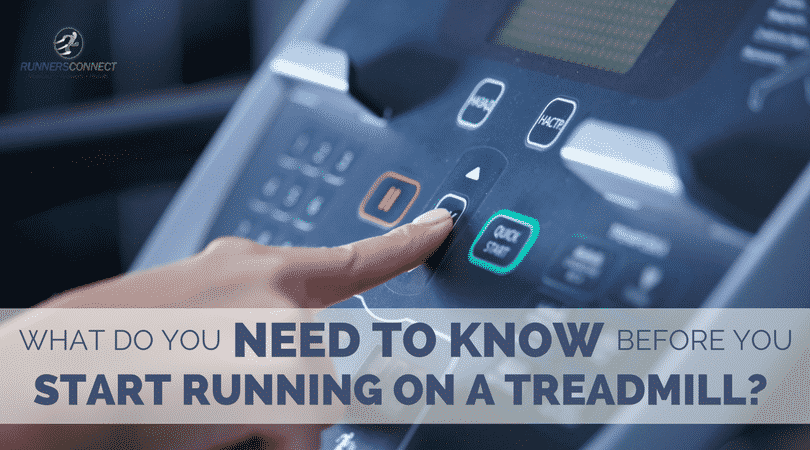One of the problems with being a runner during the winter time is that it is often unsafe to run outside.
Slippery roads, snow covered trails, and limited hours of daylight often force us inside to the treadmill for our easy days, long runs and workouts.
New to running and intimidated by the ’mill?
No worries, we’ve got you covered.
Here are the basics of how to use a treadmill for indoor running during these cold winter months, unbearable humid summer stretches, or any time running outside is not an option. What are the most important things to keep in mind for a beginner when running?
Let’s find out.

How to Run on a Treadmill
Whether you have just purchased the best state-of-the-art proform treadmill, nordictrack treadmill, or even just need to know how to use a treadmill at the gym, if you want to start running to lose weight or have a running goal you want to accomplish, the treadmill can be very intimidating.
In case you’ve never hopped on a treadmill before, and don’t even know how to turn on a treadmill (and are picturing the escalator scene in Elf), here are the basics.
The best way to start out is to stand on the belt and press the “start workout” or “quick workout” button.
Most treadmills will give you a 3…2…1… countdown before the belt begins to move.
You might be wondering:
What is a good speed for a beginner to run on a treadmill?
That is up to you.
The belt will start at a very slow walking pace, and it will be up to you to use the pace arrows to speed up to a treadmill pace that feels comfortable for you as you gain confidence on the treadmill.
Your treadmill might ask you to enter some details about your weight, age, and goal. This is optional, and most calorie counters on the treadmills are not very accurate, but if you wish to track your workout, adding these in will give you a better indication.
Make sure you have the treadmill set to your preferred training splits (miles/kilometers) and if you need help, a gym employee is the right person to ask rather than trying to guess with the buttons, better safe than sorry!
What Incline Should I Use on My Treadmill?
First and foremost, it is important to understand that treadmill running does not translate directly to outdoor running.
In order to compensate for the lack of wind resistance, set the treadmill on a 1% incline.
Most treadmills today have an incline option, and many even have a decline option, which is helpful if you are in Boston Marathon Training and need to be creative to practice downhills for race day.
However, feel free to play with this throughout the run, especially on easy days.
Consider this:
A lot of treadmills have preset programs that will adjust your incline automatically to simulate a specific hill pattern.
This can be a fun way to keep an easy run or a long run interesting.
However, playing with the incline is something you should notify your coach about.
Let’s say you are training for a long, flat race like the Chicago Marathon.
It is a good idea to get in long runs that are long and flat to simulate the muscle firing patterns and subsequent fatigue that results from running sustained, flat terrain so that your body can grow accustomed to that and there will be no surprises on race day.
However, let’s say you are training for a race like the Boston Marathon which has massive portions of downhill running.
Finding a treadmill with a decline option can be an invaluable resource, allowing your body (particularly those quads!) to adjust to the long pounding of running downhill.
This is a tool many runners utilize even when outdoor running is available so look around for a gym near you that has a treadmill with a decline option!
How to Run Treadmill Workouts
Many athletes wonder if their “on land” speed sessions can translate to the treadmill, and in most cases, the answer is YES!
What needs to be taken into consideration usually is the type of rest required for the workout.
For instance, in a workout like a basic tempo run, where an athlete runs hard for an extended number of miles (usually 3-12) with no rest in between.
It is easy to convert to a treadmill session where they simply set the treadmill at the desired pace and run until the workout is over.
For a more complicated workout, like 400 meter repeats, it is important to take the rest periods into account.
When a workout calls for standing or walking rest, it is important to figure out a game plan before you hit the treadmill.
Ramping up into a fast pace as well as slowing back down to a walking pace takes far longer on a treadmill than it does outdoors.
When a workout calls for standing or walking rest, here is the “scary” part:
How to get off a treadmill mid workout.
The best option is to simply place your hands on the hand grip of a treadmill to stabilize yourself when you reach the end of the interval, lift your body weight off the treadmill, and onto your arms, then lower your body weight onto the sides of the treadmill, while you manually push the button to slow down the treadmill, only stepping back on when the belt has returned to a very slow pace.
When ramping back up, give yourself plenty of time (20-30 seconds) before hitting your watch for the interval as the belt will not go from 0 to 60 with the snap of a finger, it takes time for the pace to ramp up safely.
Once the treadmill speed is at the pace you are comfortable with for your interval, put your arms back on the sides of the treadmill, lift your body weight up, and begin the running motion at a speed that will match the belt, and slowly lower your body down onto the belt, removing the weight from your arms as you feel comfortable.
It might seem awkward and uncomfortable at first, but you will get the hang of it pretty quick.
The treadmill is a great option for tempo and cutdown runs especially where pace control is crucial, but it is also important to be outside for these runs whenever possible, as we don’t want to become dependent on the treadmill to run our paces perfectly.
After all, we race outside, not on the treadmill!
[bctt tweet=”Need to use the treadmill? The ultimate guide for using treadmills for the first time” username=”Runners_Connect”]
How to Not be Bored on a Treadmill
The reason that most runners hate the treadmill (and may refer to it as the “dreadmill”) is because it can be a serious mental challenge to stare at the same wall or set of exercise equipment during the entire run.
Music or podcasts can be an invaluable tool to utilize during the long winter treadmill miles.
Many gym treadmills have a television option so find a channel you like and enjoy!
If you are more of a purist and prefer running unplugged, that’s fine too.
One feature that gyms with top of the line treadmills offer is a run simulation, where the runner can select a venue and virtually run trails and streets in beautiful locations!
Some of these simulations can be quite helpful, such as treadmills that offer a run down the city streets of Chicago, perfect for those training for the marathon who want a little taste of the final few miles.
Need something fun to listen to and be inspired by if motivation is lacking?
We of course recommend the Run to the Top podcast, and would recommend starting with this episode with Dick Beardsley.
Treadmill Safety Guidelines
As with any piece of complicated exercise equipment, safety is an important thing to keep in mind.
If you are nervous about using the treadmill, consider this:
Most treadmills feature a safety harness, which is a small clip that should be securely attached to your clothing when you begin running.
The clip is attached to a long string that attaches to the treadmill itself, and just in case a runner passes out or falls off the treadmill for any reason, when the string tugs hard enough, the treadmill will stop immediately, preventing further injury.
Hydration on the Treadmill
Make sure as well to bring plenty of water with you to the gym.
It can be easy to forget about hydration during the winter, but remember that most gyms are kept around 65 degrees and sweating on the treadmill is inevitable, so carry a full bottle with you and drink up!
Likewise, it can be easy to over dress when it is twenty degrees outside so make sure to have layers on that you can strip off as you warm up inside, though do be aware that many gyms have a dress code and shirtless/sports bra running is off limits.
Treadmills aren’t all bad!
Just make sure to prepare well and double check with your coach that running inside is a viable option for that day’s workout.
We live in an age that has seen many technological advances, particularly in the world of sport, so take advantage of this and give the ‘mill a chance!
RunnersConnect Bonus
Download your FREE Treadmill Guide for Runners.
The guide contains 4 treadmill specific workouts guaranteed to keep you sane and fit! You’ll learn about the In-N-Out workout, how to “run like an Egyptian” and get my favorite “green eggs and ham” workout.







